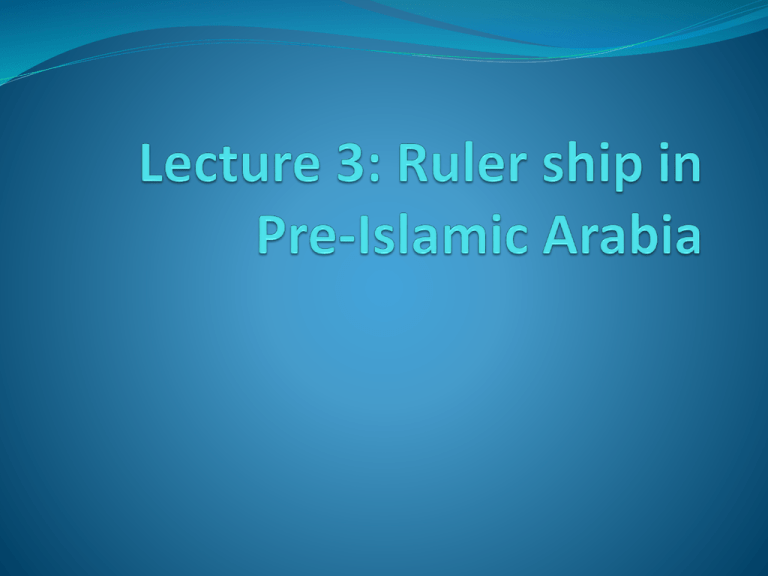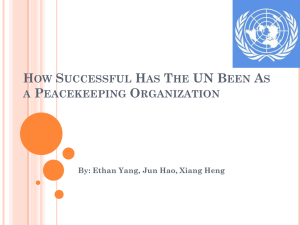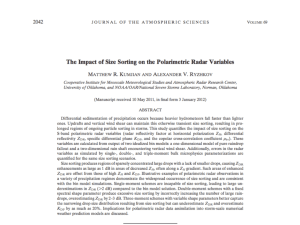
The Ages of Yemen
1) Before 650 C.E., during which their
kings were called "Makrib Sheba". Their
capital was "Sarwah.” During this period,
they started building the "Dam of
Ma’rib" which had great importance in
the history of Yemen. Had great domain
-- colonies inside and outside Arabia.
2) From 650 C.E. until 115 C.E. gave
up the name "Makrib“ and assumed
the designation of "Kings of Sheba".
They also made Ma’rib their capital
instead of Sarwah. The ruins of
Ma’rib lie at a distance of sixty miles
east of San‘a exist today.
3) 115 B.C. until 300 A.D. the tribe of
Himyar conquered the kingdom of
Sheba and took Redan for capital instead
of Ma’rib.
Later on, Redan was called "Zifar".
During this period, they began to
decline and fall. Their trade failed to a
very great extent, because:
1) Nabetean domain over N. of Hijaz;
2)Roman superiority over the naval trade routes after
the Roman conquest of Egypt, Syria and the N.
Hijaz;
3)Inter-tribal warfare.
Thanks to the three above-mentioned factors,
families of Qahtan were disunited and scattered
out.
4) From 300 C.E. until Islam
dawned on Yemen , there was
disorder and turmoil. The great
many and civil wars rendered the
people of Yemen liable to foreign
subjection and hence loss of
independence. During this era:
a) the Romans conquered ‘Adn
b) helped the Abyssinians (Ethiopians) to occupy Yemen
for the first time in 340 A.D. and until 378 A.D. Yemen
regained its independence. (Dhu Nuwas, Aryat and
Abraha)
c) Cracks in Ma’rib Dam led to the Great Flood (450 or
451 A.D) mentioned in the Noble Qur’an. Causes fall
of the entire Yemeni civilization and dispersal of the
nations living there.
How Persia came to rule Yemen?
After the "Elephant" incident, the people of Yemen under
leadership of Saif Dhu Yazin Al-Himyari & through Persian
assistance, revolted against the Abyssinian invaders,
restored independence .
Saif Dhu Yazin became king but was assassinated by
Abyssinian who served and protected him. The family of
Dhu Yazin was thus deprived of royalty forever.
As a result, Kisra, the Persian king, appointed a Persian
ruler over San‘a and thus made Yemen a Persian
colony. Persian rulers maintained rulership of Yemen until
Badhan, the last of them, embraced Islam in 638 A.D. thus
terminating the Persian domain over Yemen.
Sassanid Empire [Persian Empire]
Who established the Sassanian
state?
Ardashir in 226 C.E. regained enough
unity and power to subdue the Arabs
living in the vicinity of their kingdom,
and force Quda‘a to leave for Syria ,
leaving the people of Heerah and
Anbar under the Persian domain.
Who was the leader of Heerah?
Juzaima Alwaddah exercised ruler ship
over Heerah, Rabi‘a and Mudar, and
Mesopotamia.
What were Ardashir’s plans to rule
the Arabs?
Figured that ruling the Arabs directly not possible, but
needed a way to and prevent them attacking his
borders. So, decided to appointed a king among them
who enjoyed support and power of his tribe. He could
also use him against:
a) Byzantine kings who always used to harass him.
b) Arabs of Iraq could face the Arabs of Syria who were
allies and under control of the Byzantine kings.
Juzaima dies in 268 C.E . . .
‘
Amr bin ‘Adi bin Nasr AlLakhmi is appointed king by
Persian King Sabour bin
Ardashir, he was the first of the
Lakhmi kings who ruled
Heerah.
The appearance of Mazdak’s
religion!
Qabaz bin Fairuz now ruler of Persian, and in his reign
appeared someone called Mazdak, who called for
dissoluteness in social life. Qabaz, and many of his
subjects, embraced Mazdak’s religion and even called
upon the king of Heerah, Al-Munzir bin Ma’ AsSama’, to follow. His pride and self-respect caused him
to refuse so discharged and nominated Harith bin
‘Amr bin Hajar Al-Kindi, who had accepted the
Mazdaki doctrine to rule over Heerah.
Al-Munzir restored to throne!
Khosroe Anu Shairwan succeeds
Qabaz. He hated Mazdak’s philosophy,
so killed Mazdak and many of his
followers, and restored Munzir to the
throne of Heerah and gave orders to
summon under arrest Harith who
sought refuge with Al-Kalb tribe where
he spent the rest of his life.
Just before the birth of Prophet
(saw)
Sons of Al-Munzir bin Ma’ As-Sama’ maintained
kingship a long time until An-Nu‘man bin AlMunzir took over. Because of a calumny borne by
Zaid bin ‘Adi Al-‘Abbadi, the Persian king got
angry with An-Nu‘man and summoned him to his
palace. An-Nu‘man went secretly to Hani bin
Mas‘ud, chief of Shaiban tribe, left his wealth and
family under his protection, and then presented
himself before the Persian king, who threw him in
prison where he perished.
Khosroe declares war on the Arabs
Khosroe appointed Eyas bin Qubaisa At-Ta’i as king
of Heerah, who was ordered to order Hani bin
Mas‘ud to deliver An-Nu‘man’s charge up to Kisra. He
rejected, so Kisra declared war against the tribe of
Shaiban and mobilized troops under leadership of
King Eyas to a place called Dhee Qar. Furious battle
ensued and Arabs won for first time in history. That
was very soon after the birth of Prophet Muhammad
[saw] 8 months after Eyas bin Qubaisah’s rise to power
over Heerah.
After Eyas and until Muslims take
over Heerah
After Eyas a Persian ruler appointed
over Heerah. Then in 632 A.D. the
authority there returned to the
family of Lukhm when Al-Munzir
Al-Ma‘rur took over. Eight months
later Khalid bin Al-Waleed took
over.
Ruler ship in Syria
Septs of Quda‘a [belonging to the family of
Sulaih bin Halwan of whose offspring were the
sons of Duj‘am bin Sulaih known as AdDuja‘ima ] reached the borders of Syria and
settled down. Byzantines used them in the
defense of the Byzantine borders against both
Arab Bedouin raiders and the Persians, and
hence enjoyed autonomy for whole of second
century A.D. Their most famous king was
Zyiad bin Al-Habula.
Ghassanids
But defeated by Ghassanids who were
consequently granted the proxy ruler ship
over the Arabs of Syria and had Dumat AlJandal as their headquarters.
Lasted until the battle of Yarmuk in the year
13 A.H. when their last king Jabala bin AlAihum embraced Islam during the reign of
the Chief of Believers, ‘Umar bin Al-Khattab
Pan Arabia
Tribes dwelling near Heerah subordinate to Arabian
king of Heerah.
Those dwelling in the Syrian semi-desert under
domain of the Arabian Ghassanid king.
Those living in the hinder deserts enjoyed full
autonomy. Had heads chosen by the whole tribe which
was a demi-government based on tribal solidarity and
collective interests in defence of land and property
Heads of Tribes
Enjoyed privileges similar to kings—we obeyed in both
war and peace.
Rivalry among cousins for ruler ship. Even in
entertaining guests, generosity, wisdom and chivalry
for the sole purpose of outranking and gaining fam.
Had claims to spoils of war (1/4 of spoils, whatever he
chose for himself, or found on his way back or even the
remaining indivisible spoils.
So, the political situation . . .
3 Arab regions adjacent to foreigners suffered:
1) Weakness
2) Inferiority
3) Masters [a large part were foreigners]
Slaves [responsibilities to others]
5) arbitrary autocratic ruler ship meant encroachment
on the rights of subordinates, ignorance, oppression,
iniquity, injustice and hardship.
4)
Hijaz
Rulers of Hijaz esteemed and respected by the Arabs,
and were considered rulers and servants of the
religious centre.
Ruler ship mixture of secular and official, as well as
religious.
Looked after the interests of Al-Ka‘bah visitors and
were in charge of putting Abraham’s code into effect.
However, too weak, as seen during Abraha’s attack.
Status of Women
Among nobility she enjoyed
1) an advanced degree of esteem.
2) considerable portion of free will,
3) Her decision would most often be enforced.
4) She was so highly cherished that blood would be
easily shed in defense of her honor. Indeed, the most
decisive key to bloody fight or friendly peace (e.g
War of Basuus)
Family System among nobility. . .
Wholly patriarchal [male –
dominated]. The marriage contract
rested completely in the hands of
the woman’s legal guardian whose
word could never be questioned.
Divorce was as well.
Marriage of four kinds . . .
Abu Darr, on the authority of ‘Aishah [raa] reported four
kinds of marriage in pre- Islamic Arabia:
The first was similar to present-day marriage
procedures, in which case a man gives his daughter in
marriage to another man after a dowry has been
agreed on.
In the second, the husband would
send his wife – after the
menstruation period – to cohabit
with another man in order to
conceive. After conception her
husband would, if he desired, have
a sexual intercourse with her.
A third kind was that a group of less than ten men
would have sexual intercourse with a woman. If
she conceived and gave birth to a child, she would
send for these men, and nobody could abstain.
They would come together to her house. She
would say: ‘You know what you have done. I have
given birth to a child and it is your child’ (pointing
to one of them). The man meant would have to
accept.
The fourth kind was that a lot of men would have
sexual intercourse with a certain woman. She would
not prevent anybody. Such women used to put a red
flag at their gates to show their availability. If she got
pregnant and gave birth to a child, she would collect
those men, and a seeress would tell whose child it was.
[How? Through casting lots] The appointed father
would take the child and declare him/her his own.
When Prophet Muhammad [saw] declared Islam in
Arabia, he cancelled all these forms of sexual contacts
except that of present Islamic marriage.
Women always accompanied men in
their wars. The winners would
freely have sexual intercourse with
such women, but disgrace would
follow the children conceived in
this way all their lives.
NO limits to # of wives . . .
Pre-Islam Arabs had no limited
number of wives. They could
marry two sisters at the same
time, or even the wives of their
fathers if divorced or widowed.
Adultery was rampant . . .
Prevailed among almost all social classes
except few whose self-dignity prevented
them. Free women were in much better
conditions than the female slaves who
constituted the greatest calamity. It seemed
that the greatest majority of pre-Islam Arabs
did not feel ashamed of committing
adultery.
Infanticide (Wa’ad Al Banaat)
Who started? It is said that the first tribe to practice
this was Rabi’a. It is said that the tribes was exposed to
an invasion from another tribe. As a result, the wife of
one of their princes was take captive. After an
agreement was reached and she was asked to go back,
she refused and chose to stay with her captor . He was
so angry, that he passed a law among his tribe that all
girls should be buried, and it was followed out of fear
of the incident being repeated.
Reasons Varied:
Was across the board—among impoverished and
wealthy tribes of Arabia.
1) Jealously over their woman in culture in which they
were involved in “Ghazaw”—in which tribes would
invade other tribes and among the booty would be
their women [daughters, wives, sisters—all women of
the tribe]. So, preferred not to have to go through this
humiliation [2 tribes—Kinda Banu Tameem]
2) A vow: a tribe called Banu Tameem denied Al Nu’man
taxes they owed. So, when they refused Al Nu’man
took all the women. After some negotiations they
came to an agreement. Al Nu’man said that every
women taken captive should be asked if she would like
to go back to her husband. All of them chose to go
back but one, the daughter of Qays bin ‘Assem . So, her
humiliated and angered father Qays vowed that he
would bury any girl he had from thereon and he
buried over 10 girls. It caught like wildfire, and was
practiced as if law of the land.
3) Survival of the beauty and burial of the
“beast”: birth defects, physical defects, color
etc.
4) Poverty: at times of famine when there
was not enough food. So they used to bury
the girls, so that there would be enough to
go around among the poor.
How did they bury them?
While his wife was having a baby, would dig a hole. If it was a
girl and they did not want to keep her they would bury her.
It was customary that when the father decides to bury his
daughter he would ask the mother to prepare her. She would
perfume her and adorn her in her best clothes. Then the father
would take her out to a hole that he had dug and he would push
her in it and keep on piling dirt until he buried her.
If he kept her alive he would have her wear a hat made of camel’s
hair and would let her go and herd camel in the desert. And
when he decided to kill her, at the age of six he would tell his
wife to prepare her, and then he would take her out to the desert
where he would have already decided on a well to bury her in,
and he would tell her look in and then push her in.
)Man came to the Prophet (saw
قصة رجل وأد ابنته وقد أظهر ندمه عند النبي (ص):
روي أن رجالً من أصحاب النبي (ص) وكان ال يزال مغتما ً بين يدي
رسول هللا (ص) فقال له رسول هللا (ص) :ما لك تكون محزوناً؟ فقال :يا
رسول هللا إني أذنبت ذنبا ً في الجاهلية فأخاف أال يغفره هللا لي وإن أسلمت،
فقال له :أخبرني عن ذنبك؟ فقال :يا رسول هللا ،إني كنت من الذين يقتلون
بناتهم ،فولدت لي بنت فتشفعت إلي امرأتي أن أتركها فتركتها حتى كبرت
وأدركت ،وصارت من أجمل النساء فخطبوها ،فدخلتني الحمية ،ولم يحتمل
قلبي أن أزوجها أو أتركها في البيت بغير زواج ،فقلت للمرأة إني أريد أن
أذهب إلى قبيلة كذا وكذا في زيارة أقربائي فأبعثيها معي ،فسرت بذلك،
وزينتها بالثياب والحلي ،وأخذت علي المواثيق بأال أخونها ،الماضي.
فذهبت إلى رأس بئر فنظرت في البئر ،ففطنت الجارية أني أريد أن ألقيها في
البئر فالتزمتني وجعلت تبكي وتقول :يا أبت إيش تريد أن تفعل بي؟
فرحمتها ،ثم نظرت في البئر فدخلت عليّ الحمية ،ثم التزمتني وجعلت
تقول :يا أبت ال تضيع أمانة أمي! فجعلت مرة أنظر في البئر ومرة أنظر
إليها فأرحمها ،حتى غلبني الشيطان فأخذبتها وألقيتها في البئر منكوسة،
وهي تنادي في البئر :يا أبت قتلتني؟! ومكثت هناك حتى انقطع صوتها
فرجعت.
فبكى رسول هللا (ص) وأصحابه ،وقال :لو أُمرت أن أعاقب أحداً بما فعل
في الجاهلية لعاقبتك.
Banned!
With the coming of Islam all forms were banned, and
considered among the major sins, and was completely
eradicated from existence and we now hear about it
history .
Other social aspects . . .
"Support your brother whether he is an oppressor or
oppressed“—blood-ties dictated selectiveness in the
rendering of justice.
Fighting over leadership—like Aws and Khazraj.
Because of continuous inter-tribal warfare—there
were three months of the year in which they were not
allowed to fight. Muharram, Rajab, Dhul-Qa‘dah, and
Dhul-Hijjah—called the prohibited months.
Economy
Trade most common means of providing
their needs of life. Could not be fulfilled
unless security of caravan routes and intertribal peaceful co-existence were provided –
having the prohibited months helped them
hold assemblies such as ‘Ukaz, Dhil-Majaz,
Mijannah
Makkah in strategic area—is a top for trade
caravans—because of ZamZam.
Industries?
Knitting and tannage done by people coming from
Yemen, Heerah and the borders of Syria.
Inside Arabia there was some sort of farming and
stock-breeding.
Almost all the Arabian women worked in yarn
spinning but continually threatened by wars.
Ethics
Was the Prophet (saw) a green tree in the middle of
a desert?
Qualities in Arabs
1) Hospitality: used to rival eachother, and would
emulate one another. So, hospitable were they
that they would sacrifice their sustenance to a
cold or hungry guest. Would even take on heavy
blood money for the sake of praise and eulogy.
Even what they gambled they gave away in
charity.
2) Keeping a covenant : was a debt, that he was
ready to give up everything he owned, even his
own family, to keep his promise.
3) Sense of honor and repudiation of injustice: The
Treaty of the Virtuous [Hilf Al Fudool]
4) Firm will and determination: Stood firm in honor.
5) Forbearance, perseverance and mildness.
6) Pure and simple Bedouin life, still untarnished with
accessories of deceptive urban appearances, was a driving
reason to his nature of truthfulness and honesty, and
detachment from intrigue and treachery












